Short on time? Our pick for the best inflatable kayak is the Aquaglide Navarro 130.
Our roundup of the best lightweight kayaks so you can hit the water with ease.
Ok, full disclosure: even though I lift weights regularly and think of myself as a fit person, I am super weak when it comes to lifting heavy things. Like, embarrassingly so.
I can’t count the times I thought something was “broken” only to have a capable person push a little harder and magically get it to work.
So when it came to finding the best lightweight kayaks on the market, I was all over it. I love spending time outside and I like to carry my own weight, both literally and figuratively.
With a traditionally heavy and bulky item like a kayak, a lightweight, manageable model is a game-changer. We have two lightweight kayaks at home–both are inflatable–and we use them all the time.
Below, I’ve brought you the best lightweight kayaks for every type of recreational pursuit. Let’s dive in!
Note: this post contains affiliate links, which help run this site at no extra cost to you so I can keep providing free travel advice and tips.
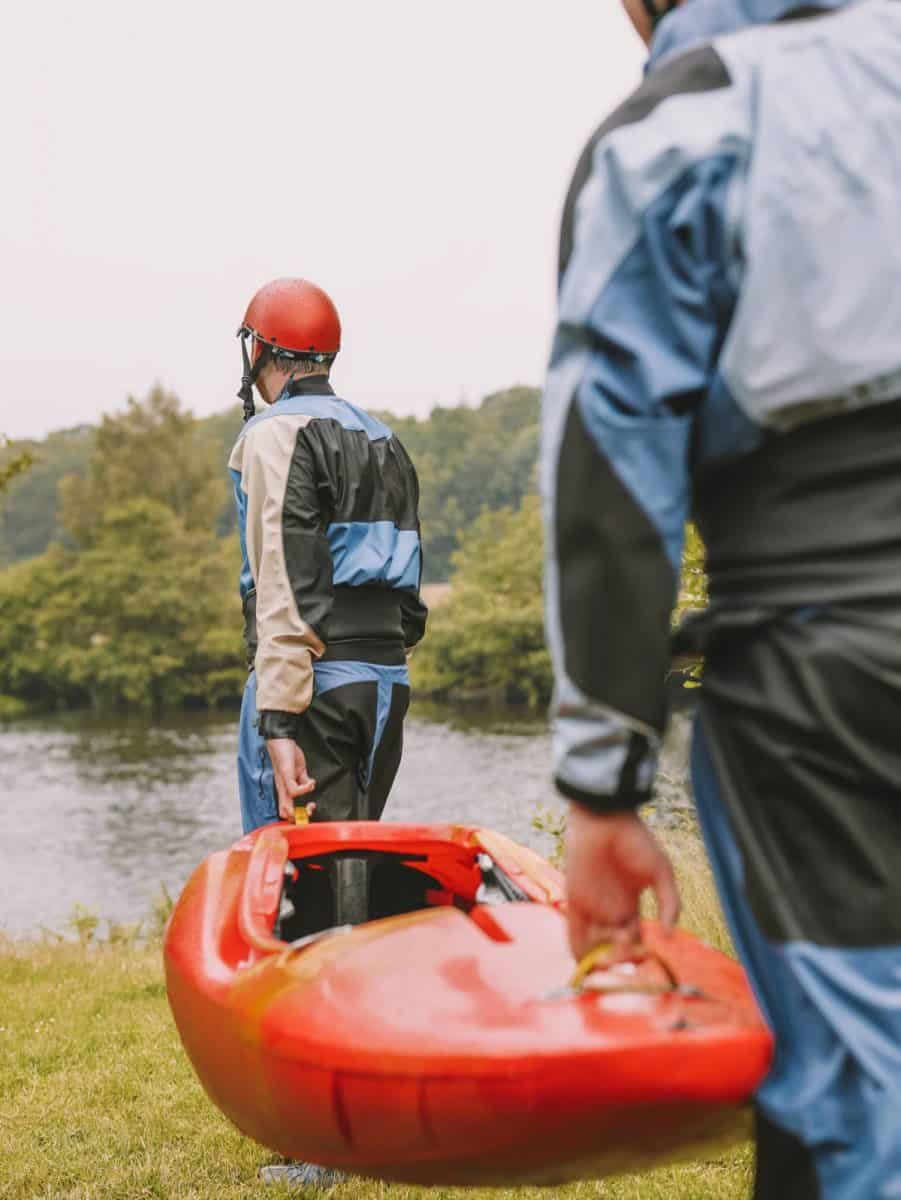
Here’s a Quick Look at Our Recommendations
- Best One-Person Lightweight Kayak – Advanced Elements Lagoon 1
- Best Two-Person Lightweight Kayak – Driftsun Almanor Inflatable Touring Kayak
- Best Lightweight Kayak for Seniors – Outdoor Tuff Stinger 3
- Best Short Lightweight Kayak – Lifetime Lotus 8’
- Best Small Lightweight Kayak – Perception High Five
- Most Lightweight Kayak – Advanced Elements Packlite
- Best Lightweight Kayak for Beginners – Intex Challenger
- Best Lightweight Sit-on-Top Kayak – Sevylor Quikpack K1
- Best Lightweight Kayak for Dogs – Driftsun Voyager
- Best Lightweight Kayak for Fishing – BKC FK184
- Best Lightweight Touring Kayak – Aquaglide Navarro 130
#1 Advanced Elements Lagoon 1
Best One-Person Lightweight Kayak
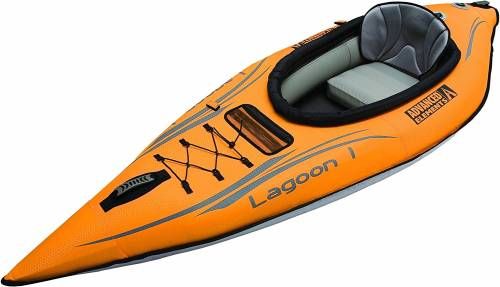
Our rating: 4.6/5
Solo or tandem: Solo
Weight: 23 lbs
Length: 8’ 4’’
Weight capacity: 250 lbs
Advanced Elements is a highly popular kayak brand, so I can’t help but include their lightweight kayaks on my list.
The Advanced Elements Lagoon 1 is a sit-inside inflatable kayak for solo paddlers.
Rigid aluminum ribs reinforce the lightweight construction on the Lagoon 1 in the bow and stern, giving it similar tracking to hard shell kayaks.
This kayak is reasonably-priced, especially for the quality of its materials. And at just 23 pounds, this is one of the best lightweight kayaks for solo paddlers.
With that said, the Advanced Elements Lagoon 1 is relatively short at 8’4’’.
Short kayaks make excellent whitewater kayaks because turning swiftly is paramount in those environments. However, this kayak has no whitewater rating, so I recommend you keep it on flat water.
One other thing to note–short kayaks can be trickier for long-distance trips because they tend to zig-zag in the water as you paddle.
The skeg on this kayak also isn’t removable, which I don’t love. But with such a short boat, you might want to keep the skeg on permanently anyway to help with tracking.
Additionally, this kayak has a padded foam seat and reinforced carrying handles on the bow and stern.
Although I’m generally impressed with Advanced Elements’ products, they notoriously don’t come with paddles or air pumps (*le sigh*).
Looking for more inflatable options? Read our guide to the best inflatable kayaks.
PROS
- Good bang for your buck
- Lightweight
- Comfortable seat
CONS
- Paddles and air pump sold separately
- Sit-inside design is slightly tricky for newbies
#2 Driftsun Almanor Inflatable Touring Kayak
Best Two-Person Lightweight Kayak
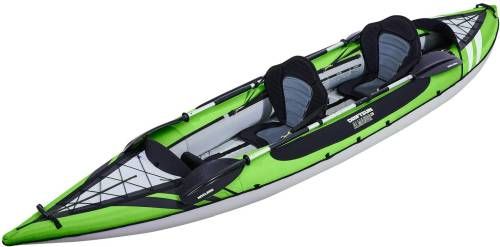
Our rating: 4.9/5
Solo or tandem: Tandem
Weight: 36 lbs
Length: 13’
Weight capacity: 400 lbs
Most hard shell two-person kayaks on the market will run upwards of 70+ lbs, but the Driftsun Almanor Inflatable Touring Kayak is just 36 lbs. This makes it one of the lightest kayaks for two people that I’ve found.
In addition to this kayak’s low weight, there’s a lot to like about it. Driftsun markets this kayak as a hybrid between a recreational and a touring kayak, and it shares some features with each.
It’s a long boat (13’), which helps it glide efficiently over long distances, but it’s also quite broad (39’’), making it stable like a recreational kayak.
Many use touring kayaks as sea kayaks, and it’s essential to have a comfortable kayak on a long ocean journey.
The Driftsun Almanor Inflatable Touring Kayak has super comfortable EVA foam-padded high-back seats. It also has adjustable foot braces for comfort and packs into a backpack-style carrier.
With that said, this lightweight tandem kayak has a max weight capacity of just 400 lbs, which is a little on the low side for two people plus a day’s worth of gear.
Looking for more two-person options? Read our guide to the best tandem kayaks.
PROS
- Adjustable padded seat
- Great for longer trips
- Fast setup time
CONS
- Low maximum weight capacity
#3 Outdoor Tuff Stinger 3
Best Lightweight Kayak for Seniors
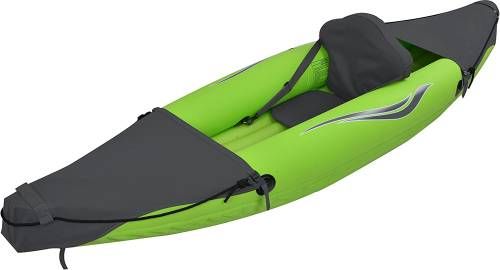
Our rating: 4.8/5
Solo or tandem: Solo
Weight: 25 lbs
Length: 9’1’’
Weight capacity: 275 lbs
If I had to pick a kayak for my grandma, I would want something lightweight with an adjustable seat that packs into a backpack and uses a foot pump to inflate.
Voila! The Outdoor Tuff Stinger 3 is the best lightweight kayak for seniors because it has all of these features.
This lightweight inflatable kayak weighs just 25 pounds but is still durable with a triple layer of PVC tarpaulin.
It has multiple air chambers (per industry standard) and comes with a foot pump, so you won’t have to bend your back up and down as you do with a regular hand pump.
The seat also has a high level of adjustability and there’s a footrest for added comfort.
The whole contraption folds into a backpack, which is super helpful because a bulky duffel bag is no good for grandmas.
The Outdoor Tuff Stinger also comes with a paddle, so there’s no need to fuss with extra costs.
One issue I have with this kayak is that the maximum weight capacity may not be as high as advertised.
I’ve come across at least one person who said that when they opened the box, the side of the boat read its capacity was 165 lbs, not 275 lbs. This makes a big difference in who can safely use this inflatable kayak.
PROS
- Lightweight
- Folds into a backpack
- Foot pump for ergonomic inflation
- Adjustable seat
- Multiple air chambers
CONS
- It may not fit big people well
#4 Lifetime Lotus 8’
Best Short Lightweight Kayak
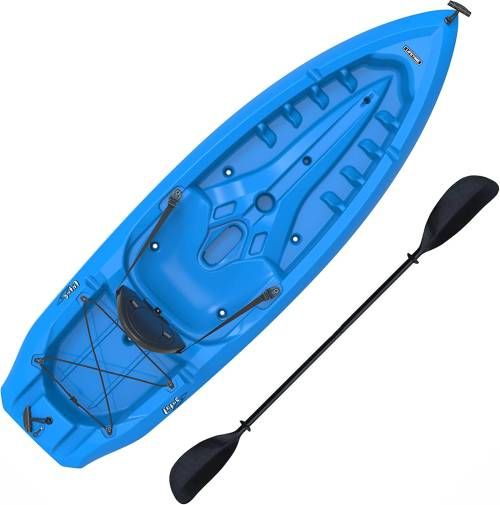
Our rating: 4.6/5
Solo or tandem: Solo
Weight: 36.5 lbs
Length: 8’’
Weight capacity: 250 lbs
If you’re looking for short and straightforward lightweight kayaks, look no further than the Lifetime Lotus 8’.
This sit-on-top lightweight boat provides an easy, affordable way to get on the water and the shorter length is great for those with small vehicles.
High-density polyethylene comprises this hardshell kayak, a standard material for cheap but sturdy recreational kayaks.
There are also built-in, molded footrests in the kayak’s body, and a storage hatch at the back provides ample storage space. Handles on both the bow and stern make moving this guy easy.
While the padded seat cushion offers *some* comfort for shorter paddlers, the seat situation is nothing to write home about. The bottom of the seat isn’t padded and the adjustable backrest is a bit thin.
Being such a short kayak, you may also find it challenging to keep this boat in a straight line. Despite this, you can work around it by adjusting the depth of your paddle.
And on the plus side, this wide kayak is very stable.
PROS
- It fits inside many SUVs
- Handles on bow and stern
- Reasonable price
- Stable hull design
CONS
- The padded seat needs an extra cushion
- Tracking isn’t great
#5 Perception High Five
Best Small Lightweight Kayak
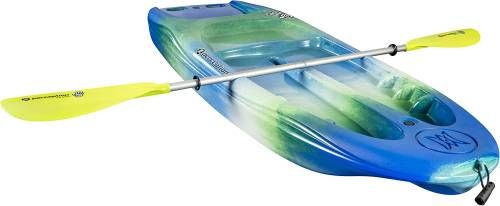
Our rating: 4.8/5
Solo or tandem: Solo
Weight: 21 lbs
Length: 6’
Weight capacity: 120 lbs
The Perception High Five is the best small kayak because the design keeps kids in mind.
At just six feet long, this kayak weighs 21 pounds and is a sit-on-top kayak. The Perception High Five has numerous features that make it one of the best kayaks for kids.
First, the back of the kayak has a swim-up deck with hand holds for kids to gain a purchase. Because, let’s be honest, most kids *are* going overboard during a paddle sesh anyway.
You can paddle this high-density polyethylene kayak either standing or sitting. And there’s a leash and a tether system that hooks the kayak to an adult kayak.
While there are molded footrests, that’s about it in terms of comfort. No inflatable seats and no storage hatch, but hey–those things aren’t priorities to kids anyway.
PROS
- Perfect for kids
- Made of durable high-density polyethylene
- Swim-up deck with handholds for safety
- Tether and leash system
CONS
- Seating may be uncomfortable for long periods
#6 Advanced Elements Packlite
Most Lightweight Kayak
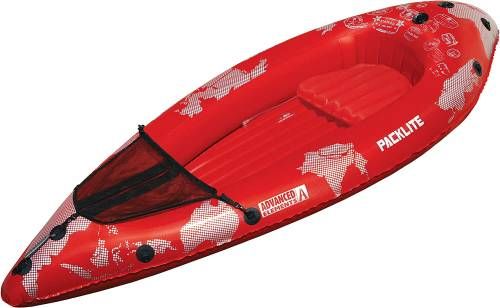
Our rating: 4.8/5
Solo or tandem: Solo
Weight: 4 lbs
Length: 7’10’’
Weight capacity: 250 lbs
If you’re looking for the absolute lightest lightweight kayaks, check out the “pack rafts” category. Most lightweight kayaks will be between 20-35 lbs, but pack rafts are in a category of their own.
Pack rafts are simple, super-light kayaks (usually between four to seven pounds) designed to haul in a backpack.
The Advanced Elements Packlite raft is simply the best lightweight kayak for any adventure where mobility is critical. This inflatable kayak weighs four pounds and packs down to the size of a Happy Meal box.
Now, as with anything that is uber light, it’s also uber light on fancy features. This versatile kayak does have an inflatable seat cushion, but that’s about it. Back support will depend on your muscles.
A mesh satchel on the front provides a bit of cargo space, but you’ll need to keep an eye on the weight you put in the Packlite because it can only hold 250 pounds.
Finally, this lightweight kayak doesn’t come with paddles or a pump.
PROS
- Incredibly lightweight
- Packs tiny
- Good stability
- Reasonably priced
CONS
- Not big enough for big people
- Paddle and pump not included
#7 Intex Challenger
Best Lightweight Kayak for Beginners
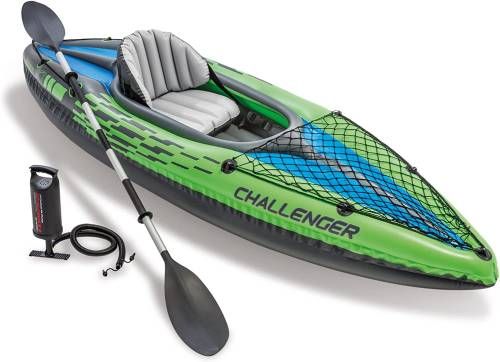
Our rating: 4.5/5
Solo or tandem: Solo
Weight: 28.4 lbs
Length: 9’
Weight capacity: 220
I almost always bring up the Intex Challenger when I review kayaks because it’s a simple, inexpensive, and easy-to-use kayak.
I have the tandem version of it, and while you shouldn’t expect miracles from this kayak, it’s fantastic for flatwater recreational paddling without hurting your pocketbook.
This lightweight kayak weighs just over 28 pounds and comes with a carrying bag, a repair kit, air pump, paddle, and a detachable skeg.
There’s also bungee deck lacing on the boat’s bow, which should provide ample storage space for dry bags.
While there’s an adjustable backrest and an inflatable seat, it may not be sufficient for very tall paddlers.
Note that this sit-in kayak has a maximum weight capacity of 220 lbs. It’s the perfect lightweight kayak for beginners, teens, or petite figures, but it may not be suitable for bigger humans.
Lastly, the setup time on this kayak is fast–under 15 minutes. Just note that the Intex Challenger doesn’t have grab lines on the ends, but it’s such a lightweight vessel you’ll hardly need them.
PROS
- Affordable
- Lightweight
- Removable skeg
- Fast setup
- Includes paddles and an air pump
CONS
- Flimsy carry bag
- Not designed for rough water
- Not suitable for big paddlers
#8 Sevylor Quikpak K1
Best Lightweight Sit-on-Top Kayak
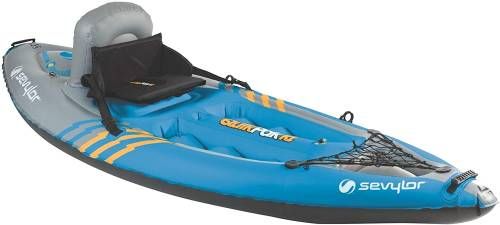
Our rating: 4.7/5
Solo or tandem: Solo
Weight: 20.28 lbs
Length: 8’7’’
Weight capacity: 400 lbs
Ok, so I debated on this one. The most lightweight kayaks are often inflatable kayaks, but inflatable kayaks *can* sit pretty high in the water, which makes them unstable.
Ultimately, I chose to let the kayak’s weight be the most crucial factor, and I’m going with the Sevylor Quikpack K1 for the best lightweight sit-on-top kayak.
At just over 20 pounds, this is one of the best lightweight kayaks for adults (that isn’t a pack raft).
This inflatable kayak includes all the basics: repair kit, paddle, air pump, plus the storage back is a backpack, so kudos for that. The Sevylor Quikpak also happens to be a budget-friendly kayak.
This simple, low-frills kayak does have molded footrests and an adjustable padded seat, but it may not be comfortable for tall folks.
Lastly, since you’ll be sitting a little high in the water on this kayak, it’s best to keep it on still water.
Looking for more budget-friendly options? Read our guide to the best budget kayaks.
PROS
- Folds up into a backpack
- Air pump and paddle included
- Fast setup time
- Budget-friendly
CONS
- The backrest is not tall enough for tall people
- Balance may be a slight challenge
#9 Driftsun Voyager
Best Lightweight Kayak for Dogs
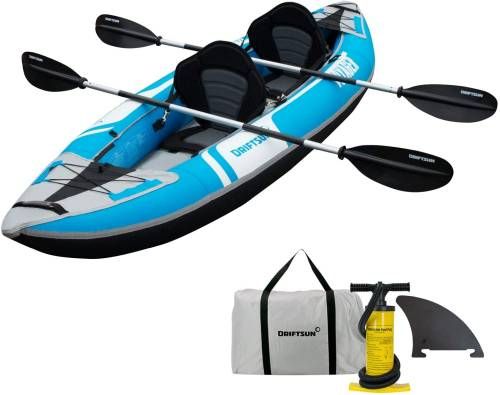
Our rating: 4.5/5
Solo or tandem: Tandem
Weight: 27 lbs
Length: 11’
Weight capacity: 400 lbs
For those who can’t leave their fur baby, a durable, lightweight kayak is in order: behold, the Driftsun Voyager.
This sit-on-top model is one of the best lightweight kayaks for you and your dog because it boasts multiple layers of heavy-duty PVC plastic plus a layer of 840-denier oxford fabric.
In other words, it’s puncture-resistant from both rocks and dog paws.
This model has foam seats–again, perfect for scratchy dog claws. And because it’s a sit-on-top model, your doggo can move about or even lie down if they want.
The packed size of the Driftsun Voyager is equal to a duffel bag, which leaves plenty of room in your car for a dog crate or other dog accessories.
This kayak has paddles, an air pump, and a removable skeg. Plus, at just 27 pounds, you should have no problem maneuvering this kayak on your own.
On the downside, I have seen a few complaints about the quality of the stitching on this kayak.
PROS
- Durable material resistant to punctures
- You can’t puncture the foam seats
- Paddles, air pump, and removable skeg included
CONS
- Low-quality stitching
#10 BKC FK184 9’
Best Lightweight Kayak for Fishing
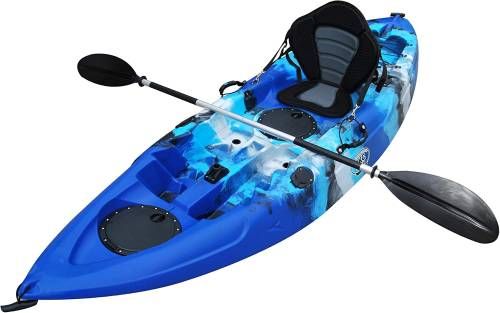
Our rating: 4.5/5
Solo or tandem: Solo
Weight: 44 lbs
Length: 9’
Weight capacity: 220
I recommend looking for these features in a fishing kayak: a wide, stable design, enclosed storage wells, a paddle holder, a cooler platform, and fishing rod holders (obviously).
Lightweight fishing kayaks can be hard to find. Traditional fishing kayaks are notoriously heavy, so the BKC FK184 is a revelation.
Fishermen often already have a lot of gear to haul, so why not find the lightest kayak model available?
At 44 pounds, the BKC FK184 isn’t the lightest boat on my list, but it’s the most lightweight fishing kayak I could find and still 30 pounds lighter than most hard-shell kayaks. Plus, it includes all the essential features a fisherman needs.
First, the design of this fishing kayak has a flat hull (bottom), making it stable enough to stand on while casting. A broad, stable hull is also very helpful when fighting a fish.
The enclosed storage wells are also convenient against splashing fish because they keep your gear perfectly dry. Alternatively, you could use the wells to hold your fish.
You’ll need both hands while fishing, so having a place to put your paddle is vital. Straps on both sides of the kayak hold your paddle while you wrestle the big one.
Having a cooler is also nice when fishing. Not only do you often want cold drinks as a fisherman, but you could also use it to put fish on ice if you’re planning to eat your catch.
Finally–and this one is a no-brainer–a fishing kayak needs rod holders. The BKC FK184 has one articulating rod holder and four flush mount rod holders.
The BKC FK184 is a fantastic and well-loved kayak, with only a few minor issues such as a lengthy shipping time and subjectively uncomfortable seats.
PROS
- Wide, stable design
- Two waterproof hatches
- Cooler platform
- Five fishing rod holders
CONS
- Slow shipping time
- The seat is uncomfortable for some
#11 Aquaglide Navarro 130
Best Lightweight Touring Kayak

Our rating: 4.9/5
Solo or tandem: Solo
Weight: 35 lbs
Length: 13’3’’
Weight capacity: 300
Traditional touring kayaks are typically quite long and thus tend to be heavy, but the Aquaglide Navarro 130 is just 35 pounds. This makes it one of the lightest sea kayaks for long-distance paddling!
The Aquaglide Navarro is a 13’3’’ long sit-inside kayak with a weight capacity of 300 pounds (more than enough for solo paddling plus gear).
And this lightweight kayak comes equipped with lots of storage space. There’s a storage hatch on the back plus mesh lacing on the front.
A rigid, drop-stitch floor and a tracking fin keep the Navarro 130 tracking in a straight line. Plus, the seat and footrest are highly adjustable, both of which are important on a long paddle.
The Aquaglide Navarro 130 has an additional deck cover splash guard, but it’s sold separately, as is their air pump and paddle.
PROS
- Great for long-distance paddles
- Lots of storage space
- Drop stitch floor
- Good tracking
CONS
- Accessories (pump, paddle, spray skirt) sold separately
Lightweight Kayak Buying Guide: How to Choose the Best one for you
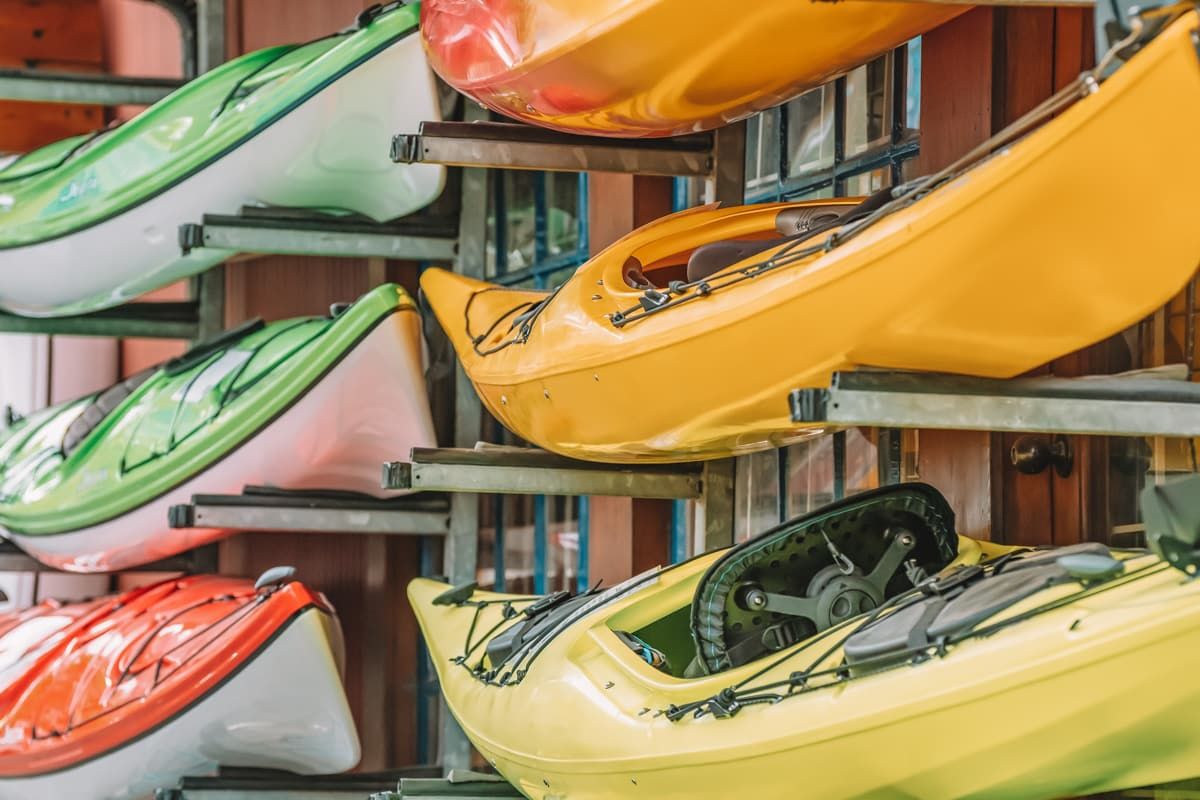
What to Look for in Lightweight Kayaks
Material
I could write a whole post on kayak building materials, but I’ll try to keep it brief.
Wood
Wooden kayaks are hard to find and usually homemade by DIYers. Wood is lighter than fiberglass but as strong as carbon fiber.
These kayaks can have a beautiful aesthetic, but they’re often expensive.
Polyethylene
You may see this material called “rotomolded polyethylene” or “high-density polyethylene.” Polyethylene is an extremely common and durable plastic ubiquitous on lower-end kayaks.
It’s not the lightest material, but don’t get snooty about it–polyethylene is highly durable and can handle many years of wear and tear with minimal upkeep.
Thermoform kayaks
Thermoformed kayaks use thin sheets of plastic that are heated and pressed against a kayak mold.
These types of kayaks are lighter than polyethylene kayaks and a little more expensive, but they also have a shinier finish.
Composite Materials
Composites use resin to coat another durable, thin material. Here are a few examples:
- Lightweight fiberglass kayaks are classic kayaks. They’re strong and cost-effective.
- Carbon fiber is the lightest and most expensive kayak material, common on competition kayaks. But you can find recreational kayaks made of carbon fiber as well.
- Kevlar, or Aramid fiber, is as strong as fiberglass but more lightweight–and often more expensive. A good, lightweight kevlar kayak will set you back a lot of $$$.
Inflatable kayaks
Inflatable kayaks use a different material than hard-shell kayaks. A few common materials include:
- PVC (Polyvinyl chloride) is the most common material for inflatable kayaks. It’s cheap, lightweight, and can layer with other materials for more durability. Note that PVC degrades in UV light and is also environmentally yucky.
- Polyurethane is durable and lightweight, has the added benefit of being UV-resistant, and is way more environmentally friendly than PVC.
- Nitrylonl is a combination of nitrile rubber and a very durable polyester fabric. It holds up better than PVC and is highly durable.
Other Factors to Look For in Lightweight Kayaks
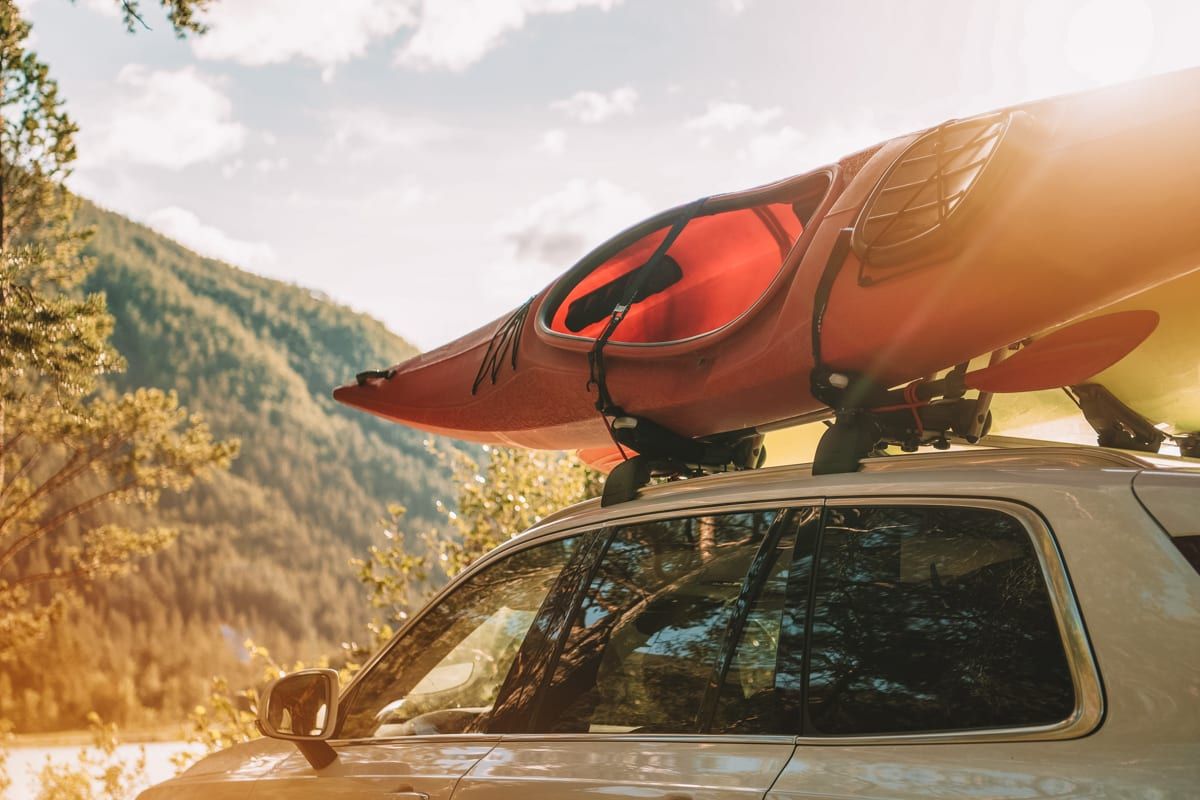
Intended use
What types of water bodies are you looking to explore in your kayak? If inland lakes and calm rivers are your jam, you’ll do fine with a recreational kayak.
If whitewater is more up your alley, look for a kayak specifically designed with a spray skirt and rated for Class III whitewater or higher.
If ocean-going is your speed, you may want to explore touring kayaks.
Width
Wider kayaks tend to be more stable and thus more beginner-friendly, while narrow boats can feel more “tippy” and are more popular among experienced paddlers.
Tracking
Tracking refers to the ability of the kayak to stay in a straight line. Longer boats have better tracking than shorter boats.
Fins (skegs) on the bottom of the boat also make a considerable difference in tracking ability.
Drop Stitch Floor
You’ll only see this feature with inflatable kayaks. You can inflate a drop-stitched floor to be entirely rigid, which improves tracking and is helpful on fishing kayaks.
Storage Space
Make sure your boat has the storage space you need, whether it’s bungee cargo lacing, a separate compartment, D-rings, or a platform to latch a cooler onto.
NMMA Certification
The National Marine Manufacturers Association certifies watercraft in the USA as having met specific safety standards.
To achieve this certification, kayak manufacturers must have their products inspected yearly. It’s a nice bonus that’s good to look for in a kayak.
Types of Lightweight Kayaks
Solo vs Tandem
The difference between solo and tandem should be pretty self-explanatory. Solo kayaks are for one person, and tandem kayaks are for two. There are also a few kayaks out there with three seats.
Sit-On-Top
Sit-on-top kayaks have an open platform design. This design can be suitable for beginners because you don’t have to learn any fancy bailing moves as you need to with a sit-inside kayak.
Sit-Inside
Sit-inside kayaks have an enclosed cockpit that only leaves your torso exposed. This design is excellent for cold water because it protects you from wind and water splashes.
Touring vs Recreational
Touring kayaks are typically longer with v-shaped bottoms designed to cross long distances efficiently.
Recreational kayaks have flat bottoms, which make them more stable and are more common for beginners or those on calm water.
Hardshell vs Inflatable
Hardshell kayaks are traditional kayaks. Inflatable kayaks are an emerging (awesome) product trend that packs into a duffel bag and inflates in a few minutes.
There’s nothing wrong with hardshell kayaks; many people find that they are faster and have better tracking than kayaks that inflate.
Inflatable kayaks are ideal for those without the storage space for a traditional kayak.
Foldable Kayaks
Folding kayaks are another category of lightweight kayaks that you should be aware of.
They’re a bit like a giant paper airplane, and while they’re certainly not the biggest category of lightweight kayak, you may see them out there.
I personally have never seen a folding kayak on the water, but if you end up buying a foldable kayak, you should write to us and let us know how you like it!
FAQs About Lightweight Kayaks
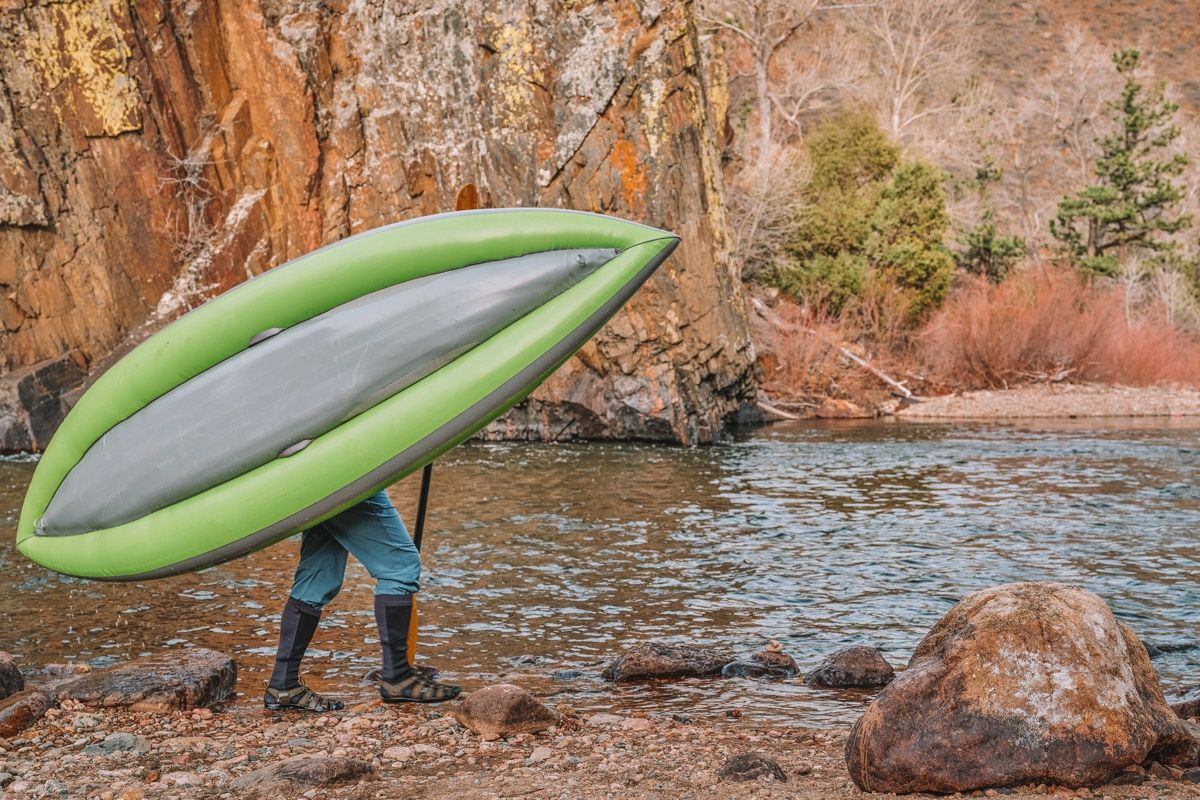
What is the smallest and lightest-weight kayak available for adults?
The smallest and most lightweight kayaks for adults are pack rafts. A pack raft is an ultralight kayak (usually under ten pounds) that you haul to the backcountry in a backpack.
For example, the Advanced Elements Packlite is a four-pound kayak that packs down to the size of a purse.
What is the lightest touring kayak?
The lightest touring kayak on our list is the Aquaglide Navarro 130. At just 35 pounds, this kayak is much easier to transport than traditional touring kayaks.
Is it better to have a short or long kayak?
Long, narrow kayaks are generally easier to keep in a straight line. They can carry more weight and are faster than shorter, wider kayaks, although also less stable.
Beginners often feel more comfortable on short kayaks because they’re more stable.
How much does an average kayak weigh? What is considered a light kayak?
Traditional hard shell solo kayaks weigh an average of 35-40 pounds, whereas two-person kayaks weigh an average of 70 pounds. A light kayak is anything under 40 pounds.
Who makes the lightest kayak paddle?
The top three lightest kayak paddles are the following:
- Wilderness Systems Pungo Kayak Paddle
- Aqua Bound Eagle Ray Carbon Kayak Paddle
- Werner Camano Fiberglass Bent Shaft Kayak Paddle
What size kayak do I need for my height and weight?
The most important thing to remember when choosing a kayak is not to exceed the maximum weight rating for your kayak. Remember that your gear should also factor into your total weight calculation.
That said, your kayak will perform at its peak if you plan to have a 100-130 pound buffer between you and your gear and the max weight capacity.
If you load your kayak down to the absolute limit, you’ll be sitting low in the water, making it harder to paddle and easier to take on water.
Watch this video to learn more about sizing your kayak:
Conclusion: Our Pick for the Best Lightweight Kayak
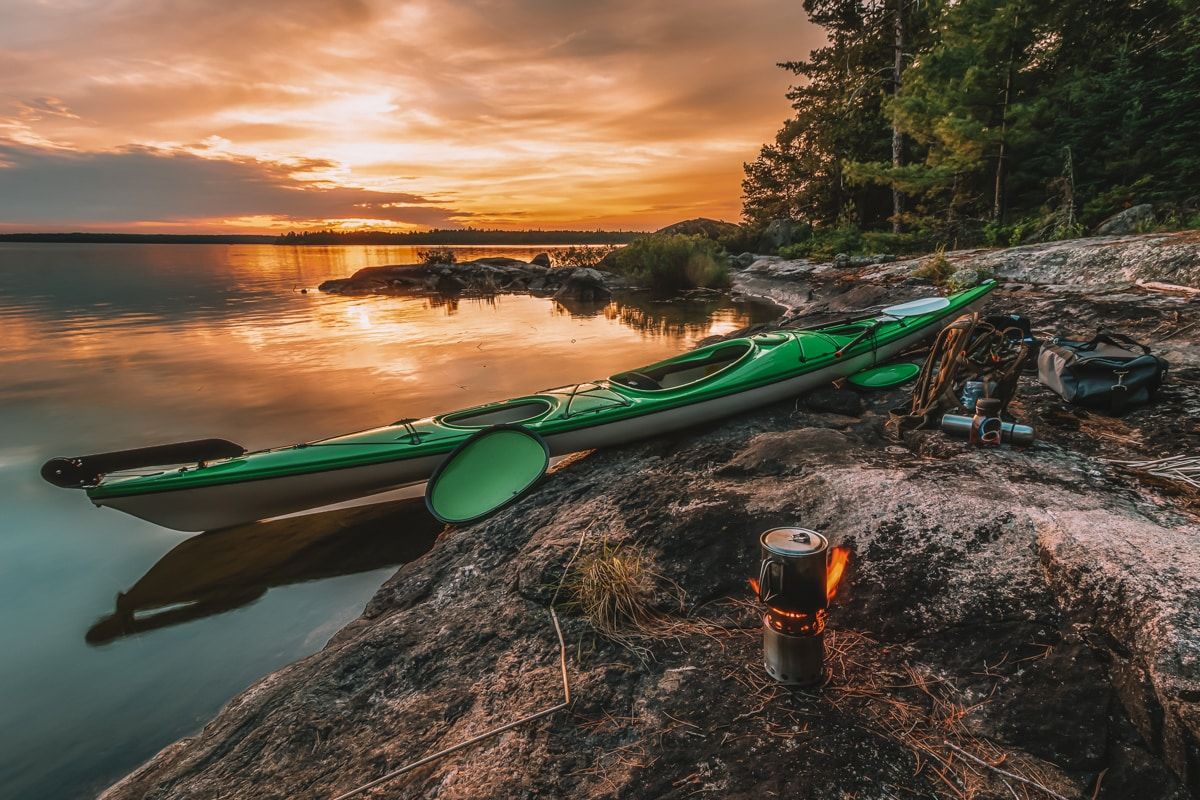
I have had so much fun with my lightweight kayaks over the years and can guarantee that the ease of moving and loading them contributed to the fun factor.
By contrast, the one time we borrowed some friends’ traditional heavy kayaks and strapped them to our roof, we were super stressed driving them down the highway.
Finding the right lightweight kayak can significantly affect how often you’re willing to take your kayak out.
After doing a ton of research to find the best lightweight kayaks on the market, I’ve chosen the Aquaglide Navarro 130 as the best lightweight kayak.
The Aquaglide Navarro 130 offers high-quality construction and design, and I like that you can use it in various water settings.
This kayak also has plenty of space, including the rear waterproof hatch and the bungee mesh on the front.
Although some of the accessories come separately, I like that it includes a spray skirt, which you can attach for added warmth.
ABOUT THE AUTHOR

Meredith Dennis
Meredith is a biologist and writer based in California’s Sierra Nevada. She has lived in 6 states as a biologist, so her intel on hiking and camping is chef’s kiss next level. One of her earliest camping memories was being too scared to find a bathroom at night on a family camping trip. Thankfully, she’s come a long way since then and she can help you get there too!
Looking for more outdoor gear recommendations? Check out our related articles below!
Best Water Shoes for Kayaking & Canoeing
Best Waterproof Walking Shoes for Women
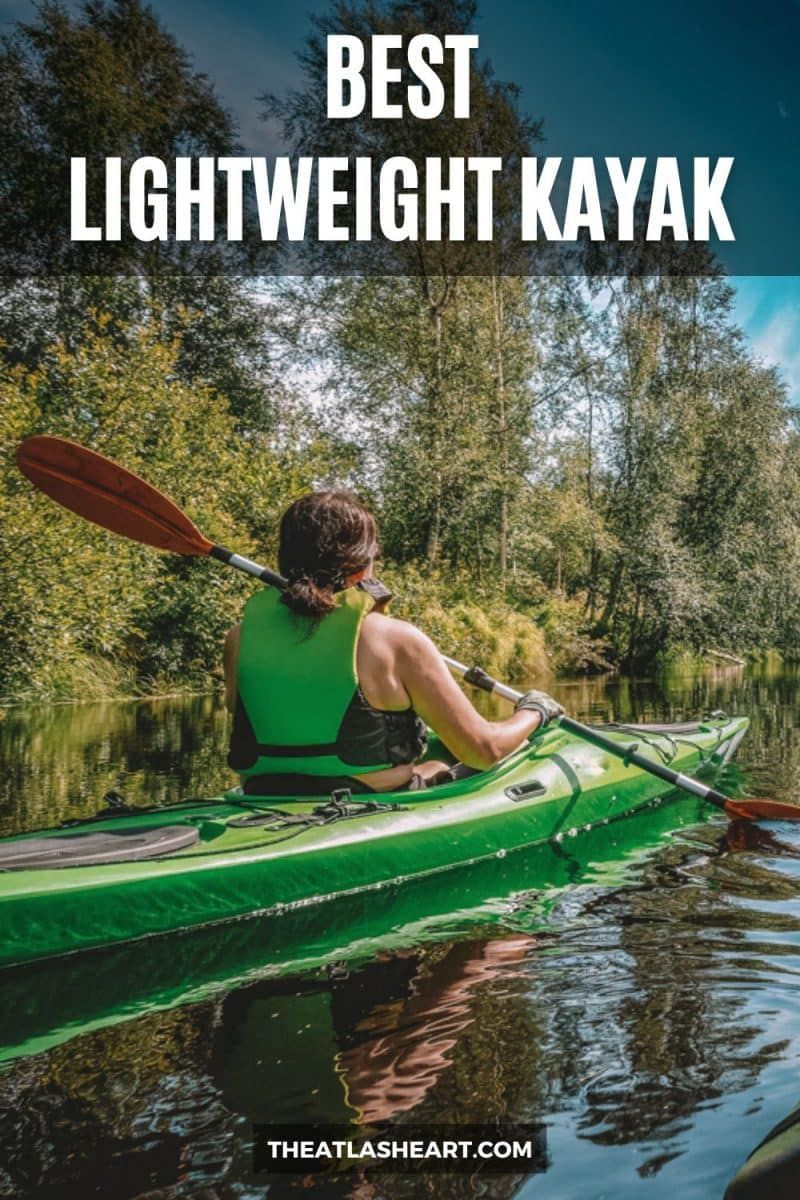
Pin this image for future reference


